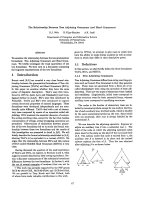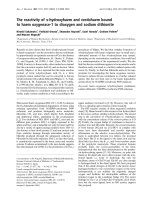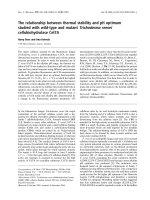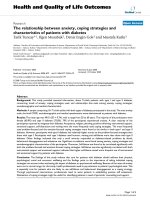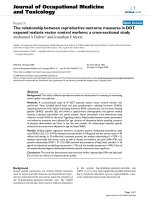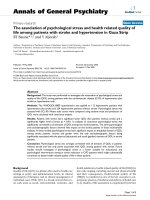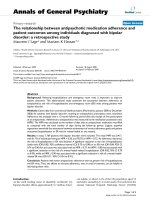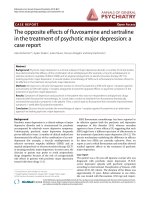Báo cáo y học: "The relationship between FV Leiden and pulmonary embolism" ppt
Bạn đang xem bản rút gọn của tài liệu. Xem và tải ngay bản đầy đủ của tài liệu tại đây (44.83 KB, 3 trang )
DVT = deep vein thrombosis; FV = factor V; PE = pulmonary embolism; VTE = venous thromboembolism.
Available online />Introduction
Pulmonary embolism (PE), a potential lethal complication
of venous thromboembolism (VTE), is a leading cause of
in-hospital death and the prevalence of symptomatic pul-
monary embolism has been estimated to be approximately
630,000 cases per year in the United States [1]. It has
also been estimated that PE may be directly responsible
for up to 100,000 deaths and a contributing cause in
another 100,000 [1]. Despite these estimates, it has been
commonly agreed that the true magnitude of PE is
unknown. The pathogenesis of VTE/PE is multifactorial
and frequently reflects the interplay between environmen-
tal, clinical and genetic factors. Although it has been long
recognized that deficiencies in the anticoagulation pro-
teins protein C, protein S and antithrombin III were often
the consequence of underlying genetic defects, there was
little interest in defining the genetics of VTE/PE. This view
changed, however, when FV Leiden was described and
subsequently shown to be associated with 18–20% of all
idiopathic VTE cases [2,3].
FV Leiden is a consequence of a single G-to-A transition
at nucleotide 1691 in the Factor V gene that results in the
amino acid substitution of an arginine by glutamine [4,5].
This single nucleotide substitution is the only known muta-
tion responsible for the FV Leiden genotype and a rapid
molecular diagnosis can thus be easily made. A pheno-
typic diagnosis, which is commonly referred to as resis-
tance to activated protein C, can also be made using
findings from the clinical hematology laboratory [6]. The
phenotypic diagnosis can be directly correlated with FV
Leiden in approximately 90–95% of cases [7]. Since the
initial description of FV Leiden, several studies have
demonstrated that the prevalence of this mutation differs
among the populations of the world, ranging from 5–12%
of individuals of northern European descent to approxi-
mately 1% in those of African descent [7–9]. For example,
in a case–control study of African-Americans with VTE, a
FV Leiden prevalence rate of 1.2% was seen in both
cases and controls [9]. Consequently, the association
between FV Leiden and VTE varies according to ethnicity.
Commentary
The relationship between FV Leiden and pulmonary embolism
W Craig Hooper and Christine De Staercke
Hematologic Disease Branch, Division of AIDS, STD, and TB Laboratory Research, National Centers for Infectious Diseases, Centers for Disease
Control and Prevention, Atlanta, USA
Correspondence: W Craig Hooper, Hematologic Disease Branch, Centers for Disease Control and Prevention, MS DO2, 1600 Clifton Rd,
Atlanta GA 30333. Tel: +1 404 639 3750; fax: +1 404 639 1638; e-mail:
Abstract
Pulmonary embolism (PE) is one of the leading causes of in-patient hospital deaths. As a
consequence, the identification of hemostatic variables that could identify those at risk would be
important in reducing mortality. It has previously been thought that deep vein thrombosis and PE are a
single disease entity and would, therefore, have the same risk factors. This view is changing, however,
with the realization that the prevalence of FV Leiden, a recognized genetic risk factor for deep vein
thrombosis, may be a ‘milder’ genetic risk factor for PE. These observations suggest that PE is not only
associated with a different set of risk factors, but may be reflective of a different clot structure.
Keywords: FV Leiden, genetics, pulmonary embolism, venous thrombosis
Received: 24 April 2001
Revisions requested: 12 June 2001
Revisions received: 14 August 2001
Accepted: 21 August 2001
Published: 19 November 2001
Respir Res 2002, 3:8
This article may contain supplementary data which can only be found
online at />© 2002 BioMed Central Ltd
(Print ISSN 1465-9921; Online ISSN 1465-993X)
Page 1 of 3
(page number not for citation purposes)
Respiratory Research Vol 3 No 1 Hooper and De Staercke
FV Leiden and pulmonary embolism
As VTE was thought to represent a single pathological
process, clinical investigators believed that the risk factors
associated with deep vein thrombosis (DVT) were the
same for PE. Manten et al. [10] hypothesized that FV
Leiden would be more common in patients with PE since
resistance to activated protein C may lead to the develop-
ment of a larger, more extensive clot, which would lead to
a subsequent increased risk for PE. To validate this
hypothesis, Manten and colleagues [10] used a VTE clini-
cal diagnosis to divide their study population of 279
patients into three groups. These comprised patients with
DVT with no signs or symptoms of PE (n = 211), patients
with PE with no signs or symptoms of DVT (n = 45), and
patients who were clinically diagnosed as having both
DVT and PE (n = 23). Acquired VTE risk factors, such as
hospitalization and surgery, were similar among the three
study groups . After adjusting for age and sex, the preva-
lence of FV Leiden was lowest in patients with PE (8.9%)
and highest in patients with only DVT (17.5%). The preva-
lence for patients with both DVT and PE was 13.0%, inter-
mediate between the two other groups. In comparison, the
prevalence of FV Leiden in the control group was approxi-
mately 3.0%. These data demonstrate that the relative risk
for PE in the individuals with FV Leiden was approximately
three-fold while the risk for DVT was about seven-fold in
the FV Leiden carriers [10]. In another study, Martinelli et
al. [11] found that the 4.9% prevalence of FV Leiden in
patients with isolated PE was about the same as that
found in the controls. To more fully define these findings,
Turkstra et al. [12] ascertained the FV Leiden prevalence
in an unselected group of 92 patients who had an objec-
tively confirmed diagnosis of PE. Of these, 67 presented
with only a primary PE and the FV Leiden prevalence in
this group was 7.4%. The FV Leiden prevalence in the
remaining 25 patients, who had both DVT and PE, was
24.0%.
A related question raised by these studies is whether or
not the FV Leiden prevalence was higher in cases that
were associated with a fatal PE. Using autopsy material,
Vandenbroucke et al. [13] divided autopsied individuals
into two groups. The first consisted of a consecutive
series of autopsies in which PE was described as an inci-
dental finding; the majority of these patients had a major
underlying disease. The second group consisted of a
series of cases in which PE was the sole cause of death in
individuals under the age of 70 with no known acquired
risk factors for VTE. Although these investigators stated
that they could not rule out selection bias in terms of
patients autopsied, or technical bias due to the use of
paraffin blocks, their results were nevertheless similar to
the earlier findings. In the first autopsy series, the FV
Leiden prevalence of 2.3% was comparable to that of the
general population. The prevalence of 10% found in the
second autopsy series reflected only a three-fold increase
in risk, a relative risk below what would have been
expected for DVT [13]. In addition to the work by Vanden-
broucke and colleagues, three further studies by other
investigators also used autopsy material to look at the rela-
tionship between FV Leiden and PE and found no associa-
tion [14–16].
FV Leiden and the prothrombin G20210A
variant
Since FV Leiden was first described, another DNA single
nucleotide substitution, the prothrombin G20210A variant,
has also been linked to an increased risk for VTE [17].
Meyer et al. [18] assessed the prevalence of both FV
Leiden and the prothrombin G20210A variant in a series
of 773 consecutive patients with an objective diagnosis of
VTE. Similar to the other studies, the cases were divided
into three groups comprising patients with DVT only, PE
only, and DVT with PE. As in the earlier studies, this study
found FV Leiden to be less common in the PE only cases
than in the other two groups [18]. They did, however, find
that the prevalence of the prothrombin G20210A variant
was similar in the three groups. It was further noted that
both mutations were present in 10 patients with DVT and
in two patients with only PE [18]. In a similar study that
also looked at both mutations, Margaglione et al. [19] ana-
lyzed 647 consecutive referred patients and 1,329 con-
trols. They also found the prevalence of both mutations in
patients with isolated PE to be comparable to those found
in the controls. In analysis of autopsy material from 67
patients who died suddenly from PE, Kohlmeier et al. [20]
also found the prevalence of prothrombin G20210A
variant and FV Leiden to be similar to that found in the
general population.
The relationship between PE and DVT
As noted by Bounameaux [21], the relationship between
FV Leiden, DVT and PE represented a ‘paradox’ in that the
published reports were not necessarily supportive of the
concept that DVT and PE represented two clinical expres-
sions derived from one disease, namely VTE. There are
currently two prevailing hypotheses to explain the appar-
ent paradox. In one, selection bias has been suggested as
the cause, as most of the PE cases came from unselected
patients while most of the information linking FV Leiden
and DVT has come from central referral centers. The other
hypothesis is that the paradox is actually a reflection of the
clot structure and its location [10,21,22]. In support of the
latter hypothesis, Bjorgell et al. [22] used phlebography in
a prospective study to score the location and extent of
DVT in 247 consecutive patients. The results were then
correlated with the presence and absence of FV Leiden.
These demonstrated that incidences of DVT in the
iliofemoral veins occurred about eight-fold less in FV
Leiden carriers than in non-carriers [22]. Their analysis did
show, however, that FV Leiden was a true DVT risk factor
below the iliofemoral segments. This finding is particularly
Page 2 of 3
(page number not for citation purposes)
interesting because another study has reported that DVTs
located in the iliofemoral vein segments are more likely to
be associated with PE [23].
Conclusions
The above observations support earlier suggestions that
clot location and size may be important determinants in
defining the embolic risk [10]. As suggested by Manten et
al. [10], these initial clot parameters may be influenced by
different etiologic mechanisms (for example, stasis and
genetics) and one such mechanism could lead to an
inflammatory reaction that would amplify thrombin genera-
tion with the likely consequence of a more stable, adher-
ent clot [10]. It could thus be further argued that the
magnitude of the inflammatory response may not only be a
primary factor in determining the embolic potential of the
clot, but could also be an important factor in VTE patho-
genesis in the absence of any prothrombotic genetic risk
factors.
The clinical implications of these observations remain
uncertain and the findings do not discount the prevailing
belief that DVT and PE are a consequence of a single
disease entity. They do suggest, however, that a better
understanding of the disease is essential to ensure the
accurate use of genetic information. One possible way
forward is to initiate a prospective multi-center study
based on the seminal work of Bjorgell et al. [22] that
would include not only phlebography, but also a full hemo-
static and genetic analysis.
References
1. Anderson FA, Wheeler B, Goldberg RJ, Hosmer DW, Patwardhan
NA, Jovanovic B, Forcier A, Dalen JE: A population based per-
spective of the hospital incidence and case-fatality rates of
deep vein thrombosis and pulmonary embolism. Arch Intern
Med 1991, 151:933-938.
2. De Stefano V, Chiusolo P, Paciaroni K, Leone G: Epidemiology
of factor V Leiden: clinical implications. Seminar Thromb
Hemost 1998, 24:367-379.
3. Price DT, Ridker PM: Factor V Leiden mutation and the risks
for thromboembolic disease: A clinical perspective. Ann Intern
Med 1997, 127:895-903.
4. Greengard JS, Sun X, Xu X, Fernandez JA, Griffin JH, Evatt B:
Activated protein C resistance caused by Arg506Gln mutation
in Va. Lancet 1994, 343:1361-1362.
5. Bertina RM, Koeleman BPC, Koster T, Rosendaal FR, Driven RJ,
de Rhonde H, van der Velden PA, Reitsma PH: Mutation in blood
coagulation factor V associated with resistance to activated
protein C. Nature 1994, 369:64-67.
6. Rosen SB, Sturk A: Activated protein C resistance: a major risk
factor for thrombosis. Eur J Clin Chem Clin Biochem 1997, 35:
501-516.
7. Hooper WC, Evatt BL: The role of activated protein C resis-
tance in the pathogenesis of venous thrombosis. Am J Med
Sci 1998, 316:120-128.
8. Ridker PM, Miletich JP, Hennekens CH, Buring JE: Ethnic distrib-
ution of Factor V leiden in 4047 men and women. Implications
for venous thrombosis screening. JAMA 1997, 277:1305-
1307.
9. Hooper WC, Dilley A, Ribeiro MJA, Benson J, Austin H, Silva V,
Wenger NK, Rawlins PA: Racial difference in the prevalence of
the Arg506
→→
Gln mutation. Thromb Res 1996, 81:577-581.
10. Manten B, Westendorp RGJ, Koster T, Reistma PH, Rosendaal
FR: Risk factor profiles in patients with different clinical mani-
festations of venous thromboembolism: A focus on the factor
V Leiden mutation. Thromb Haemost 1996, 76:510-513.
11. Martinelli I, Cattaneo M, Panzeri D, Mannucci PM: Low preva-
lence of factor V:Q506 in 41 patients with isolated pulmonary
embolism. Thromb Haemost 1997, 77:440-443.
12. Turkstra F, Karemaker R, Kuijer PMM, Prins MH, Buller HR: Is the
prevalence of the factor V Leiden mutation in patients with
pulmonary embolism and deep vein thrombosis really differ-
ent ? Thromb Haemost 1999, 81:345-348.
13. Vandenbroucke JP, Bertina RM, Holmes ZR, Spaargaren C, Van
Krieken JHJM, Manten B, Reitsma PH: Factor V Leiden and fatal
pulmonary embolism. Thromb Haemost 1998, 79:511-516.
14. Dunn ST, Trong S: Evaluation of role of Factor V Leiden muta-
tion in fatal pulmonary thromboembolism. Thrombosis Res
1998, 91:7-14.
15. Gorman TE, Arcot A, Baker P, Prior TW, Brandt JT: Prevalence of
the factor V Leiden mutation among autopsy patients with
pulmonary thromboembolic disease using an improved
method for Factor V Leiden detection. Am J Clin Pathol 1999,
111:413-417.
16. Slovacek KJ, Harris AF, Greene JF, Rao A: Fatal pulmonary
embolism: A study of genetic and acquired factors. Molec
Diag 2000, 5:53-58.
17. Poort SR, Rosendaal FR, Reitsma PH, Bertina RM: A common
genetic variation in the 3’-untranslated region of the pro-
thrombin gene is associated with elevated plasma prothrom-
bin levels and an increase in venous thrombosis. Blood 1996,
88:3698-3703.
18. Meyer G, Emmerich J, Helley D, Arnaud E, Nicaud V, Alhenc-
Gelas M, Aiach M, Fischer A-M, Sors H, Fiessinger JN: Factors V
Leiden and II 20210A in patients with symptomatic pulmonary
embolism and deep vein thrombosis. Am J Med 2001, 110:12-
15.
19. Margaglione M, Brancaccio V, De Lucia D, Martinelli M, Ciampa A,
Grandone E, Di Minno G: Inherited thrombophilic risk factors
and venous thromboembolism. Chest 2000, 118:1405-1411.
20. Kohlmeier RE, Cho CG, Bux RC, Guerra L, Rulon JJ, Selby DM,
Gulley ML: Prothrombin gene mutation uncommon in pul-
monary embolism. South Med J. 2000, 93:1073-1077.
21. Bounameaux H: Factor V Leiden paradox: risk of deep vein
thrombosis but not of pulmonary embolism. Lancet 2000, 356:
182-183.
22. Bjorgell O, Nilsson PE, Nilsson J-A, Svensson PJ: Location and
extent of deep vein thrombosis in patients with and without
FV:R 506Q mutation. Thromb Haemost 2000, 83:648-651.
23. Moser KM, Lemoine JR. Is embolic risk conditioned by location
of deep venous thrombosis? Ann Int Med 1981, 94:439-444.
Available online />Page 3 of 3
(page number not for citation purposes)
